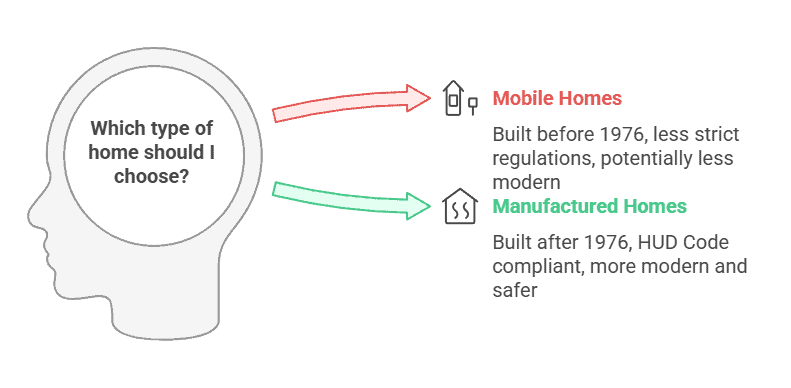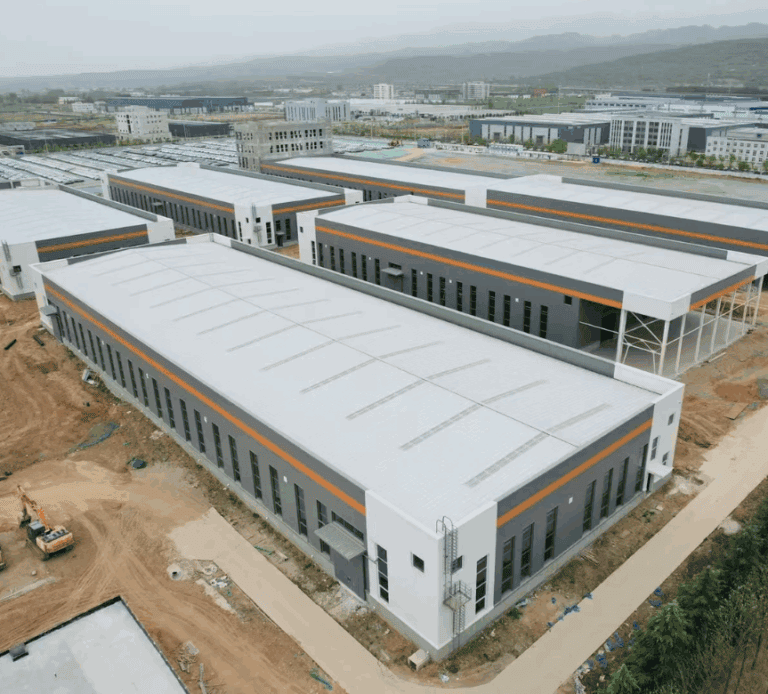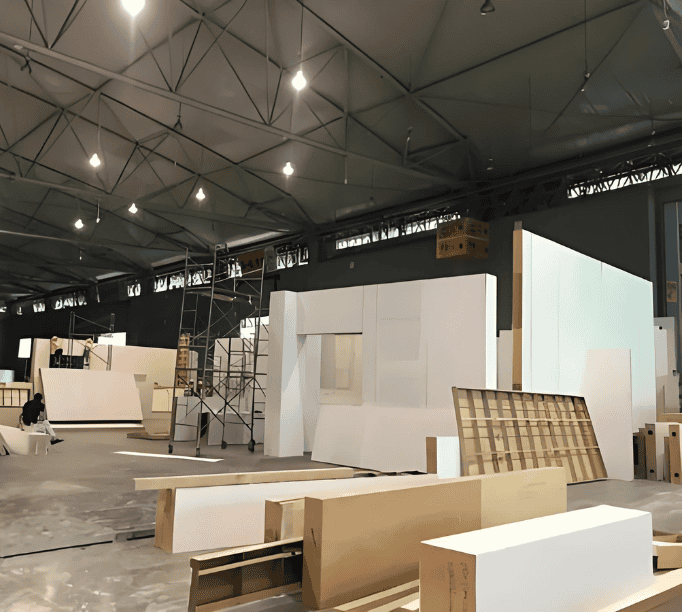Al hablar de vivienda asequible, los términos "casa móvil" y "casa prefabricada" se usan frecuentemente como sinónimos; sin embargo, no son idénticos. Entonces, ¿cuál es la verdadera diferencia?
Comprender esta distinción es crucial, ya que afecta su presupuesto, su inversión a largo plazo e incluso el tipo de financiamiento que puede obtener. Ya sea que busque una vivienda permanente o un inversionista que busca una rentabilidad sólida, saber qué opción se adapta mejor a sus necesidades es clave.
En este artículo, analizaremos las diferencias clave entre las casas móviles y las casas prefabricadas, lo ayudaremos a comprender las consideraciones prácticas de cada una y lo guiaremos sobre cómo elegir la opción correcta para sus objetivos.
¿Qué son las casas móviles y las casas prefabricadas?
Primero, vamos a presentar brevemente estos dos tipos de casas.
¿Qué son las casas móviles?
Las casas móviles, también conocidas como remolques, fueron construidas antes de 1976En aquel entonces, no existían códigos de construcción estandarizados, lo que significaba que cada vivienda se construía con distintos niveles de calidad y seguridad. Estas viviendas estaban diseñadas para ser portátiles, lo que permitía a los propietarios reubicarlas de un sitio a otro. Sin embargo, la ausencia de normativas a menudo resultaba en problemas de durabilidad y riesgos de seguridad.
¿Qué son las casas prefabricadas?
Las casas prefabricadas son la versión moderna. Construidas después de 1976Estas casas están construidas de acuerdo con estrictos estándares federales establecidos por el Código de HUD (Vivienda y Desarrollo Urbano).
Este código garantiza que las casas prefabricadas sean seguras, duraderas y cumplan con estándares de construcción específicos. A diferencia de las casas móviles, una vez instaladas sobre cimientos permanentes, las casas prefabricadas no están diseñadas para ser reubicadas.
El Código HUD rige todo, desde el diseño estructural hasta los sistemas eléctricos, lo que hace que las casas prefabricadas sean mucho más confiables y consistentes que las casas móviles más antiguas.
Diferencias clave entre casas móviles y casas prefabricadas
Diferencias clave en la terminología
También habrá notado que el término "casa móvil" sigue siendo ampliamente utilizado, aunque técnicamente se refiere a casas construidas antes de 1976. Hoy en día, el término "casa prefabricada" es el correcto, pero la terminología antigua se mantiene debido a la tradición y la familiaridad del mercado. Por lo tanto, cuando se habla de "casas móviles" hoy en día, a menudo se refieren a casas prefabricadas construidas según las normas actuales.
Normas de construcción y diseño
Casas móviles: Construidas antes de 1976, las casas móviles no estaban sujetas a las estrictas regulaciones actuales. Por lo tanto, su calidad de construcción podía variar considerablemente. No existían normas nacionales que garantizaran la seguridad, la durabilidad ni la eficiencia energética.
Casas prefabricadas: Después de 1976, se implementó el Código HUD, que estableció normas obligatorias para diversos aspectos, como la integridad estructural, la plomería y los sistemas eléctricos. Las casas prefabricadas están diseñadas para cumplir con estas normas, lo que significa que se obtiene un nivel mucho mayor de seguridad y calidad.
Seguridad y durabilidad
Casas móviles: Si bien algunas casas móviles antiguas han resistido bien el paso del tiempo, otras podrían no ser tan seguras ni duraderas debido a la falta de normativa. Estas casas se construyeron con menos requisitos de seguridad, lo que podría hacerlas propensas a sufrir daños o desgaste, especialmente en condiciones climáticas adversas.
Casas prefabricadas: Las casas prefabricadas se construyen para resistir condiciones climáticas más severas. El Código HUD garantiza que estas casas cumplan con los estándares de seguridad modernos, lo que las hace más duraderas. También están diseñadas para durar más, con mejor aislamiento, estructuras más robustas y materiales de mejor calidad.
Percepción del mercado
Casas móviles: Aunque aún son comunes en algunas zonas, las casas móviles suelen considerarse menos atractivas en el mercado inmobiliario actual. Su reputación de anticuadas, menos duraderas y difíciles de financiar puede convertirlas en una inversión más difícil.
Casas prefabricadas: Estas casas prefabricadas son ahora ampliamente aceptadas como una opción de vivienda legítima. Gracias a su cumplimiento con los estándares modernos, suelen mantener su valor mejor que las casas móviles más antiguas. De hecho, las casas prefabricadas pueden aumentar su valor con el tiempo, al igual que las casas tradicionales, especialmente si se ubican en terrenos de su propiedad.
Flexibilidad y limitaciones de instalación
Casa móvil: Tiene un chasis de remolque de acero en la parte inferior y puede ser transportado por un tractor. Sin embargo, este diseño también presenta limitaciones: muchas comunidades prohíben el estacionamiento aleatorio, y el movimiento frecuente puede causar deformaciones estructurales o daños en las tuberías.
Casa prefabricada: Según las regulaciones del Departamento de Vivienda y Desarrollo Urbano (HUD), su instalación debe fijarse sobre una base permanente (como una base de concreto) y conectarse al sistema municipal de agua y electricidad. La reubicación requiere un equipo profesional para su desmontaje y montaje, y el costo puede ascender a decenas de miles de dólares. Por lo tanto, una casa prefabricada se asemeja más a una "casa móvil tradicional" que a una residencia temporal.
Tamaño y estética
Casa móvil: Limitado por las antiguas regulaciones de transporte por carretera, el ancho no suele superar los 4,3 metros (14 pies), con una estructura estrecha de una sola planta, y parece una caravana extendida. La fachada está hecha principalmente de placas metálicas baratas o materiales de vinilo, que envejecen y se oxidan con facilidad.
Casa prefabricada: La tecnología moderna permite a las fábricas producir casas de doble o incluso triple ancho, con un ancho de hasta 8,5 metros (28 pies) y una altura de piso de hasta 2,7 metros (9 pies). La fachada puede ser de imitación de madera o de mampostería, y el techo puede diseñarse con inclinación, prácticamente igual que en las casas tradicionales. Algunos modelos de alta gama incluso cuentan con garajes y porches.
Dificultades de financiación y atributos legales
Casa móvil: Legalmente, suele clasificarse como "bien personal", similar a los coches o los yates. Al comprar, se debe solicitar un préstamo prendario, con un enganche alto (20%-30%) y una tasa de interés entre 2% y 5% superior a la de una hipoteca. Si la vivienda no tiene terreno propio, se debe pagar una renta adicional.
Casa prefabricada: Si la casa está fijada permanentemente en su propio terreno, puede solicitar el mismo préstamo hipotecario que una casa tradicional (como un préstamo FHA), con un pago inicial de tan solo 3.5% y una tasa de interés similar a la de una hipoteca convencional. El título de propiedad puede convertirse en propiedad inmobiliaria después de la instalación, lo que mejora la credibilidad del activo.
Diferencia en los rendimientos de las inversiones
Casa móvil: Debido a los bajos estándares de construcción y la imagen negativa de la comunidad, el valor generalmente se deprecia con el tiempo.
Casa prefabricada: Una vivienda bien mantenida puede revalorizarse ligeramente en su propio terreno. Sin embargo, si se alquila en la comunidad, el margen de revalorización sigue siendo limitado.

Casa móvil vs casa prefabricada: ventajas y desventajas
Ventajas y desventajas de las casas móviles
Ventajas:
- Precio bajo: El costo de compra inicial es bajo, mucho más bajo que las casas tradicionales, adecuado para presupuestos limitados o necesidades de vivienda a corto plazo.
- Flexibilidad a corto plazo: Viene con un chasis móvil y se puede mover rápidamente a diferentes áreas, adecuado para personas que necesitan cambiar de residencia con frecuencia.
Desventajas:
- Problemas de envejecimiento y mantenimiento: debido a los bajos estándares de construcción, el uso a largo plazo es propenso a la corrosión estructural, el envejecimiento de las tuberías y otros problemas, y el costo de mantenimiento es alto.
- Restricciones comunitarias: La mayoría de las comunidades residenciales modernas prohíben el estacionamiento y, por lo general, solo se pueden ubicar en parques de casas móviles específicos y se deben pagar alquileres de parcelas a largo plazo.
- Riesgo de depreciación: el valor de la propiedad continúa disminuyendo con el tiempo, lo que dificulta su reventa y su inversión como activo.
Ventajas y desventajas de las casas prefabricadas
Ventajas:
- Alta relación coste-beneficio: ofrece espacio habitable y calidad similar a las casas tradicionales, adecuado para familias autoocupadas a largo plazo.
- Garantía de seguridad: Cumple con los estándares de seguridad federales (Código HUD), tiene una fuerte resistencia a terremotos y al fuego y costos de seguro más bajos.
- Opciones de personalización: Admite una configuración personalizada desde el diseño del apartamento hasta la decoración de interiores, y algunos modelos pueden actualizarse con funciones de ahorro de energía.
Desventajas:
- Alto costo de instalación: Se requiere una inversión adicional en costos de cimentación fija, y el proceso de instalación es complicado y requiere mucho tiempo.
- Prejuicios comunitarios: Algunas comunidades tradicionales aún tienen estereotipos sobre las casas prefabricadas y pueden enfrentar restricciones en la selección del sitio o problemas de aceptación del vecindario.
¿Debería elegir una casa móvil o una casa prefabricada?
Ahora que ya conoces las diferencias entre casas móviles y Casas prefabricadasEs hora de centrarse en los factores prácticos que influirán en su decisión.
1. Presupuesto y asequibilidad: ¿cuál se adapta a su situación financiera?
Si tienes un presupuesto ajustado, casas móviles Puede parecer la opción más económica, pero hay costos a largo plazo que considerar. A continuación, un breve resumen:
Casas móviles:
- Menor costo inicial.
- Se deprecian más rápido con el tiempo.
- Más alto costos de mantenimiento y reparaciones debido a sistemas obsoletos.
Casas prefabricadas:
- Mayor costo inicial.
- Mantener o aumentar el valor con el tiempo.
- Más bajo costos de mantenimiento y menos reparaciones gracias a los estándares de construcción modernos.
Si busca valor a largo plazo y menos complicaciones, las casas prefabricadas suelen ser una inversión más favorable.
2. Mantenimiento y longevidad: ¿Cuánto tiempo y dinero está dispuesto a gastar?
Casas móviles:
- A menudo requieren reparaciones frecuentes.
- Plomería, sistemas eléctricos, y aislamiento Puede que necesite actualizaciones.
- Vida útil más corta en comparación con las casas prefabricadas.
Casas prefabricadas:
- Construido para cumplir con las normas más estrictas Código HUD normas.
- Requerir Menos mantenimiento con el tiempo.
- Durar más y son más duraderos, reduciendo los costos a largo plazo.
Si prefiere un menor mantenimiento y una casa más duradera, Casas prefabricadas son el camino a seguir
3. Zonificación y cuestiones legales: ¿Cuáles son las regulaciones en su área?
Las leyes de zonificación y las normativas locales influyen significativamente en su decisión. A continuación, le mostramos cómo se compara cada tipo de vivienda:
Casas móviles:
- Puede estar sujeto a leyes de zonificación restrictivas en ciertas áreas.
- Puede ser difícil de financiar debido al menor valor percibido.
- Encontrar un lugar para colocar una casa móvil puede ser desafiante.
Casas prefabricadas:
- Más fácil de lugar en terrenos con regulaciones de zonificación más flexibles.
- Más fácil de financiar debido a los estándares de construcción modernos.
- Tratado de manera similar a casas tradicionales por la mayoría de las autoridades locales.
Antes de tomar una decisión, consulte siempre las leyes de zonificación locales y asegúrese de que el tipo de vivienda elegido esté permitido en el lugar donde desea vivir.
¿Cuál es la mejor opción para usted?
Ahora que ha considerado los aspectos prácticos como el presupuesto, el mantenimiento y las leyes de zonificación, es hora de pensar en su objetivos específicos. Ya sea que seas un comprador de vivienda o un inversorSus necesidades determinarán qué tipo de vivienda funciona mejor para usted.
1. Para compradores de vivienda: ¿Qué opción se adapta a su estilo de vida?
Si va a comprar una casa para vivir, la decisión dependerá en gran medida de sus planes a largo plazo y su estilo de vida. Esto es lo que debe considerar:
| Factor | Casas prefabricadas | Casas móviles |
| Para la vida a largo plazo | Construido para durar, se revaloriza, requiere menos reparaciones, es una mejor inversión a largo plazo. | Costo inicial más bajo, se deprecia más rápido, más reparaciones a lo largo del tiempo |
| Para una solución a corto plazo | No es ideal para el corto plazo, pero es más estable a largo plazo. | Ideal para vivienda temporal, pero se deprecia rápidamente y necesita más mantenimiento. |
Si estás en esto para el largo plazo, Casas prefabricadas Ofrecen mejor estabilidad y valor a largo plazo.
2. Para inversores inmobiliarios: ¿cuál ofrece un mejor retorno de la inversión?
Para los inversores, Casas prefabricadas Generalmente ofrecen una mejor retorno de la inversión (ROI)Están construidas con estándares modernos, mantienen o aumentan su valor con el tiempo y son más fáciles de financiar y vender. Si se ubican en terrenos propios, es probable que se revaloricen, lo que las convierte en una inversión estable.
Si tú buscas un casas móviles Inicialmente son más baratos, se deprecian rápidamente y son más difíciles de financiar o vender. Además, conllevan mayores costos de mantenimiento, lo que los hace menos atractivos para los inversores que buscan rentabilidades estables.
Lectura relacionada: Modular vs fabricado vs móvil
Superando los desafíos en las casas móviles y prefabricadas
Tanto las casas móviles como las prefabricadas presentan sus propios desafíos. Sin embargo, con el enfoque adecuado, puede superarlos y disfrutar de un hogar confortable.
Casas móviles: depreciación potencial y financiación limitada
Las casas móviles suelen considerarse una solución de vivienda menos permanente. Esta percepción puede llevar a... depreciación y opciones de financiación limitadas, lo que dificulta su venta y la obtención de préstamos. Además, puede ser difícil encontrar terrenos adecuados para colocar una casa móvil, especialmente en zonas con leyes de zonificación restrictivas.
Soluciones:
- Selección cuidadosa de terrenosAsegúrese de que el terreno donde planea ubicar su casa móvil esté correctamente zonificado y cuente con la infraestructura necesaria (por ejemplo, servicios públicos). Esto evitará problemas de zonificación más adelante.
- Invertir en mantenimientoEl mantenimiento regular puede ralentizar la depreciación y prolongar la vida útil de su casa móvil. Actualizar elementos obsoletos, como la plomería o los sistemas eléctricos, puede aumentar el valor y la comercialización de una vivienda.
- Busque Financiamiento EspecializadoAlgunos prestamistas se especializan en el financiamiento de casas móviles. Investigue programas que ofrezcan mejores tasas o enganches más bajos para casas móviles para ampliar sus opciones de financiamiento.
- Considere una fundación permanenteColocar una casa móvil sobre una base permanente puede mejorar su valor y ayudar a que se aprecie con el tiempo.
Casas prefabricadas: obstáculos regulatorios y complejidades de instalación
Si tú buscas un Casas prefabricadas Si bien ofrecen mayor durabilidad y potencial de inversión a largo plazo, conllevan sus propios desafíos, particularmente en torno a... obstáculos regulatorios y complejidades de instalaciónEl costo inicial potencialmente más alto también puede ser un factor a considerar, particularmente si opera con un presupuesto limitado.
Soluciones:
- Comprenda las regulaciones locales: Antes de comprar, familiarícese con las normativas locales de zonificación y los códigos de construcción. Esto le ayudará a garantizar que su casa prefabricada cumpla con todos los requisitos necesarios, evitando retrasos o costos adicionales durante la instalación.
- Instalación profesionalLas casas prefabricadas requieren una instalación adecuada para asegurar su correcta colocación sobre sus cimientos. Contratar profesionales con experiencia en la instalación de casas prefabricadas ayudará a garantizar que todo se realice según las normas, evitando problemas futuros.
- Planifique los costos inicialesDado que las casas prefabricadas suelen tener un costo inicial más alto, es fundamental presupuestar adecuadamente. Considere los gastos asociados con la casa, la instalación, el terreno (si es necesario) y cualquier mejora esencial.
- Mantenimiento y garantíaAsegúrese de aprovechar las garantías del fabricante, que pueden cubrir ciertos problemas de instalación y estructurales. El mantenimiento regular de la casa también ayudará a preservar su valor y a que funcione sin problemas durante muchos años.
Tomar la decisión correcta para su futuro
A estas alturas, ya debería tener una comprensión clara de las diferencias entre las casas móviles y las casas prefabricadas, así como de los factores prácticos a considerar al elegir la opción adecuada para sus necesidades. Elegir la casa ideal no se trata solo de elegir la opción más económica, sino de invertir en algo que le brinde valor y seguridad durante años.
En SteelPRO PEB, entendemos que cada comprador e inversionista de vivienda tiene necesidades únicas, y estamos aquí para guiarlo hacia la decisión correcta. Explore nuestra casas modulares móviles Para ver cómo se adaptan a sus planes, no dude en contactarnos si tiene alguna pregunta. Nuestro equipo está listo para ayudarle a dar el siguiente paso hacia su hogar perfecto.
Tu viaje comienza con el conocimiento: ahora es el momento de actuar.

